We regularly hear of the animals that are facing extinction due to climate change, but there are some animals that are going to thrive as global temperatures increase. Here’s a rundown of some surprising ones.
Spiders
If you’re afraid of spiders, this fact will scare you. Studies have found that higher temperatures will cause spiders to spread to other areas that were previously cold but now are hospitable to them. Scarily, this also means that venomous spiders will be migrating to these warmer regions. But that’s not all. Researchers have found that hotter temperatures are set to make arachnids move faster. This is due to how they use fluid in their bodies to move their legs. When this fluid becomes warmer, they move quicker. In fact, the studies found that hotter temperatures made spiders move three times faster than they did in colder temperatures.
Cockroaches
We know that they have a pretty neat defence against environmental changes, but it seems even global warming isn’t going to be a threat for cockroaches. These stubborn animals are equipped to deal with the changing temperatures because scientists have found they can actually hold their breath in order to protect them from loss of water. Since they lose water from their respiratory surfaces when they breathe, cockroaches can adapt their breathing process to survive. They can stop breathing for up to 40 minutes at a time, thus dealing with changes in oxygen and humidity. If they find themselves in dry environments, they’ll take shorter breaths than they would in wet conditions.
Mosquitos
Since animals that thrive the most during global warming are those that can spread to various regions quickly, we can expect to see more insects. One of these is the mosquito. An example is the Asian Tiger Mosquito that has been spreading to warmer regions so that it can beat the chilly weather. But what’s most worrying about the spread of mosquitos is that they carry various diseases, such as malaria and Dengue Fever, which means that they can infect more people in different areas than before.
Bark Beetles
This is another insect that could be making global warming work for it, but it’s bad news for us yet again. When trees suffer drought, they are a target for the beetles that feed on them. Since the weather’s warmer, these beetles will be able to spread, reaching even more trees and those that are higher up. Research has found that damage to trees in British Columbia specifically by mountain pine beetles causes the forest to release even more carbon dioxide. In fact, it is said that by 2020, the forests will release more carbon dioxide than they absorb. This is because the trees will be killed off, unable to absorb carbon dioxide, but by decomposing they will release it into the air.
Pink Salmon
It’s amazing to think that some animals are capable of adapting to changes in temperature, showing how resilient they can be. One of these is the pink salmon found in Auke Creek in Alaska. The creek has been heating up by .03 degrees Celsius every year, causing the salmon to schedule their migration out of it earlier. By studying this move, scientists have discovered that this change is genetic. The salmon have evolved over a few generations to adapt to the changing climate, which gives science hope that other animals could possibly do the same thing.











